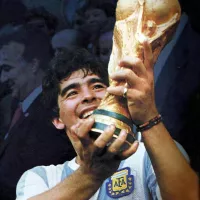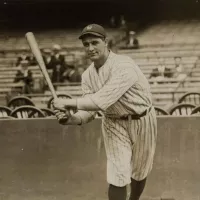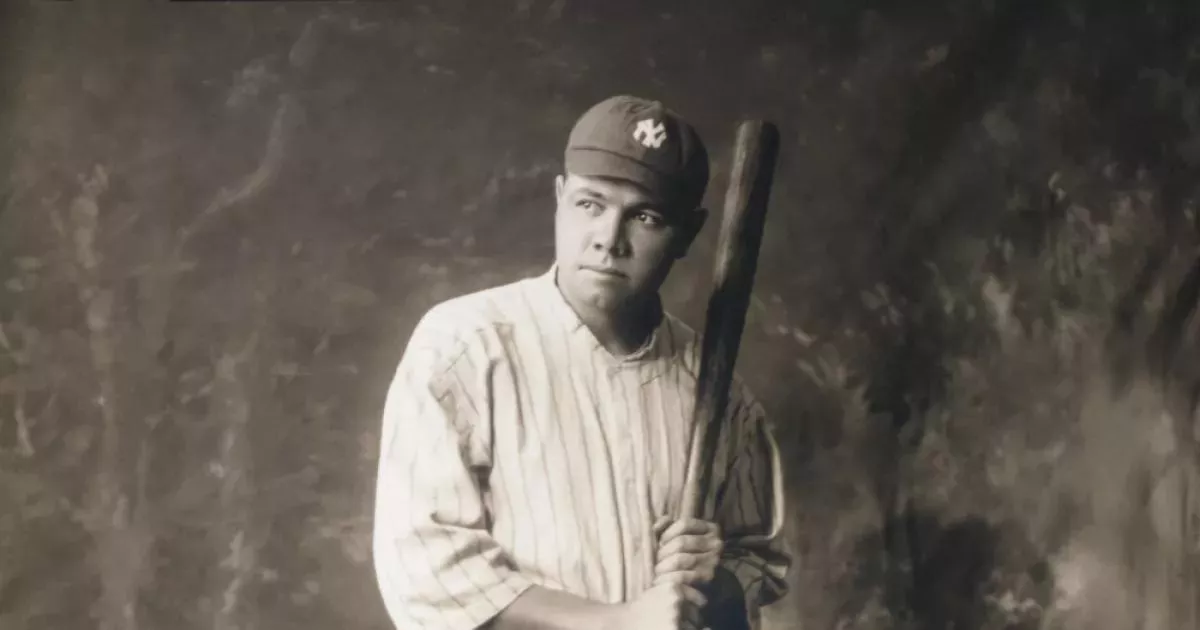From career breakthroughs to professional milestones, explore how Babe Ruth made an impact.
Babe Ruth, nicknamed "the Bambino" and "the Sultan of Swat," was a legendary American baseball player whose MLB career spanned from 1914 to 1935. Initially a star left-handed pitcher for the Boston Red Sox, he rose to prominence as a slugging outfielder for the New York Yankees. Ruth is widely regarded as one of the greatest sports heroes in American culture and is considered by many to be the greatest baseball player of all time. He was elected to the Baseball Hall of Fame in 1936 as one of its inaugural members.
1902: Ruth Breaks AL single-season mark
On July 29, 1919, Babe Ruth matched the AL single-season mark of 16 home runs, set by Ralph "Socks" Seybold in 1902.
March 7, 1914: First appearance as a professional ballplayer
On March 7, 1914, Babe Ruth made his first appearance as a professional ballplayer in an inter-squad game, playing shortstop and pitching the last two innings, contributing to a 15–9 victory. He also hit a long home run during his second at-bat.
July 11, 1914: Ruth's arrival in Boston and first game with the Red Sox
On July 11, 1914, Babe Ruth arrived in Boston and won his first game as a pitcher for the Red Sox that afternoon, with a score of 4-3 over the Cleveland Naps. The catcher was Bill Carrigan, who was also the Red Sox manager. Also on this day, Ruth met Helen Woodford, who would become his first wife.
July 30, 1914: Red Sox to Send Replacement to Grays
On July 30, 1914, Boston Red Sox owner Joseph Lannin, who had recently purchased the Providence Grays, announced that the Red Sox would send a replacement player to the Grays. This announcement was made to appease Providence fans upset about losing a star player. Babe Ruth was intended to be this replacement, but his move was initially delayed.
August 18, 1914: Ruth Joins the Grays
On August 18, 1914, Babe Ruth officially joined the Providence Grays, a minor league team. He was deeply influenced by the team's manager, "Wild Bill" Donovan, and credited Donovan with teaching him a great deal about pitching.
March 1915: Ruth Attends Spring Training
In March 1915, Babe Ruth reported to Hot Springs, Arkansas, for his first major league spring training with the Boston Red Sox.
1915: Ruth's Successful 1915 Season
In 1915, Babe Ruth finished the season with an 18-8 record as a pitcher and batted .315 with four home runs. Although the Red Sox won the AL pennant, Ruth was not called upon to pitch in the 1915 World Series but was used as a pinch hitter.
1916: Carrigan Retires After 1916 Season
After the 1916 season, Red Sox player and manager Carrigan retired and returned to his native Maine. During the same offseason, Lannin sold the team to a group headed by Harry Frazee, who hired Jack Barry as manager.
1916: Ruth's Dominance in 1916
In 1916, Babe Ruth had repeated pitching duels with Walter Johnson. Ruth went 23-12 for the season, with a 1.75 ERA and nine shutouts, both of which led the league. The Red Sox won the pennant and World Series, with Ruth winning Game 2 in 14 innings.
1917: Ruth's 1917 Season
In 1917, Babe Ruth led the league with 35 complete games and went 24-13 with a 2.01 ERA. He was ejected from a game on June 23 against Washington and suspended. Ernie Shore relieved him and retired all 26 batters.
1918: Ruth's 1918 Season
In 1918, Babe Ruth primarily played as an outfielder due to World War I shortening the season. He hit .300 with 11 home runs, tying for the major league home run title. He also had a 13–7 pitching record with a 2.22 ERA. In 1968 and 1969, there were considerations to adjust his recorded home run statistics.
1918: Red Sox Win 1918 World Series
In 1918, the Red Sox won their third pennant in four years and faced the Chicago Cubs in the World Series. Babe Ruth pitched and won Game One, a 1-0 shutout. He also pitched in Game Four, which the Red Sox won, giving Ruth his second win of the Series. The Red Sox won the Series four-games-to-two. He also set a record for consecutive scoreless innings that stood for over 40 years.
1918: Ruth ties career best
In July 1919, Babe Ruth tied his career-best of 11 home runs from 1918.
March 1919: Ruth Accepts Three-Year Contract
In March 1919, Babe Ruth reportedly accepted a three-year contract for a total of $27,000 with the Boston Red Sox, following protracted negotiations.
December 26, 1919: Frazee Sells Ruth's Contract to the Yankees
On December 26, 1919, Harry Frazee, owner of the Boston Red Sox, sold Babe Ruth's contract to the New York Yankees, a transaction that would alter the course of baseball history.
1919: Speculation about Ruth's 1920 Performance
Baseball statistician Bill James theorized that Babe Ruth's 1920 explosion might have happened in 1919 under different circumstances, such as a full season, less pitching, and a different home field.
1919: Ruth Focuses on Hitting in 1919
In 1919, Babe Ruth was primarily used as a hitter and played in 130 games and only pitched in 17, compiling a 9–5 record. Ruth's concentration on hitting led to an unprecedented spell of home runs.
January 6, 1920: Ruth's Sale to Yankees Announced
On January 6, 1920, the sale of Babe Ruth to the New York Yankees was officially announced. Ruth agreed to fulfill the remaining two years of his contract with a $20,000 bonus payable over two seasons.
1920: Yankees Jersey
In 1920, Babe Ruth's Yankees jersey that was later sold for $4.4 million.
1920: First Installment Due for Ruth Sale
In 1920, a $25,000 payment was due on November 1 as part of the sale of Babe Ruth to the Yankees.
1920: Barrow Hired as Yankees Business Manager
In 1920, after the death of Harry Sparrow, Ruppert and Huston hired Ed Barrow to be the Yankees' business manager.
1921: Ruth Breaks Home Run Record and Leads Yankees to Pennant
In 1921, Babe Ruth broke Roger Connor's career home run record and set a new single-season record with 59 home runs, leading the Yankees to their first pennant.
1921: Ruth's Contract Renegotiation Demands
In 1921, Babe Ruth demanded that his salary of $10,000 per year be doubled, or he would sit out the season. Ruth had signed the contract before the 1919 season.
1921: Second Installment Due for Ruth Sale
In 1921, a $25,000 payment was due on November 1 as part of the sale of Babe Ruth to the Yankees.
March 4, 1922: Ruth Signs New Contract
On March 4, 1922, Babe Ruth signed a new three-year contract for $52,000 a year with the Yankees, a record-breaking salary at the time.
1922: Final Installment Due for Ruth Sale
In 1922, a $25,000 payment was due on November 1 as part of the sale of Babe Ruth to the Yankees, completing the financial transaction.
1922: Ruth's 1922 Season and World Series Performance
In 1922, despite being named Yankees' captain then stripped of it, Ruth's season was considered a disappointment and his performance in the World Series was poor, as the Yankees lost to the Giants.
April 18, 1923: Yankee Stadium Opens
On April 18, 1923, Yankee Stadium opened, and Babe Ruth hit the first home run in the new ballpark, quickly dubbed "the House that Ruth Built".
1923: Yankees Win AL Pennant and World Series
In 1923, the Yankees, led by Babe Ruth, dominated the season, securing the AL pennant by a significant 17-game margin. Ruth achieved a career-high .393 batting average, tied for the most home runs in the major leagues with 41, and hit 45 doubles. The Yankees faced the Giants in the World Series for the third consecutive year and won their first World Series championship. Ruth's performance in the series included a .368 batting average, three home runs, and a slugging percentage of 1.000.
1924: Ruth Wins AL Batting Title
In 1924, despite the Yankees battling injuries and a strong challenge from the Senators, Babe Ruth won his only AL batting title with a .378 average and led the league with 46 home runs.
1926: Yankees Win Pennant, World Series Loss
In 1926, Babe Ruth returned to form, batting .372 with 47 home runs and 146 RBIs, leading the Yankees to a pennant win. In the World Series against the St. Louis Cardinals, Ruth hit three home runs in Game Four. However, the Yankees lost the series in Game Seven when Ruth was thrown out attempting to steal second base.
1927: Stared Out At Tom Zachary
In 1927, Babe Ruth stared out at Tom Zachary on a certain September afternoon.
1927: Yankees Dominate, Ruth Breaks Home Run Record
In 1927, the New York Yankees, known as Murderers' Row, dominated baseball, winning a then-AL-record 110 games and the AL pennant by 19 games. Babe Ruth broke his own single-season home run record on September 30th, hitting his 60th homer. The Yankees then swept the Pittsburgh Pirates in the World Series.
1928: Yankees Win World Series
In 1928, the Yankees overcame a mid-season slump to clinch the pennant. Babe Ruth hit 54 home runs, ending the season on a slump, and the Yankees swept the favored Cardinals in the World Series. Ruth batted .625 and hit three home runs in Game Four.
1930: Ruth's Performance, Yankees' Third-Place Finish
In 1930, Babe Ruth hit .359 with 49 home runs and 153 RBIs. The Athletics won their second consecutive pennant and World Series as the Yankees finished third. Ruth unsuccessfully sought the manager job, with Joe McCarthy replacing Shawkey.
1931: Yankees Second to Athletics
In 1931, despite the team improving, the Yankees were no match for the Athletics. Babe Ruth hit .373, with 46 home runs and 163 RBIs.
1932: Ruth desires to be a manager
In 1932, Babe Ruth expressed that he was not ready to leave the field, despite being considered for the Red Sox managerial position.
1932: "Called Shot" Jersey Sold
In 1932, The jersey Babe Ruth wore when hitting his "called shot" home run in the World Series.
1932: 1932 World Series Against the Cubs
In 1932, the Yankees played the Chicago Cubs in the World Series, marked by animosity due to a dispute over World Series shares. During Game Three in Chicago, amidst hostile crowds, Babe Ruth allegedly pointed towards center field before hitting a home run, which became known as Babe Ruth's called shot. The Yankees won the game and clinched the series the next day.
1932: Yankees Win Pennant
In the 1932 season, the Yankees went 107–47 and won the pennant. Ruth's effectiveness had decreased somewhat, but he still hit .341 with 41 home runs and 137 RBIs.
July 6, 1933: First MLB All-Star Game
On July 6, 1933, Babe Ruth played right field in the first Major League Baseball All-Star Game at Comiskey Park in Chicago. He hit the first home run in All-Star Game history, a two-run blast against Bill Hallahan in the third inning, helping the American League win the game 4-2.
July 13, 1934: 700th Career Home Run
On July 13, 1934, Babe Ruth hit his 700th career home run. Despite a .288 batting average with 22 home runs, it was considered "merely mortal" compared to his earlier performance. He was also selected to the AL All-Star team.
1934: Hat from the 1934 season
In 1934, Babe Ruth had a hat from the season.
1934: Desire to Manage Yankees
In 1934, Babe Ruth openly campaigned to manage the Yankees, a job that was never a serious possibility as the team owner supported the current manager. By the end of the season, Ruth hinted that he would retire if he wasn't named manager.
1934: Managerial Opportunities
In 1934, Babe Ruth was offered the managerial position for the Newark Bears, the Yankees' top minor-league team, but declined at the advice of his wife and business manager. He also delayed a meeting with the Tigers, who were considering him for a player-manager role, to go on a trip to Hawaii. The Tigers ultimately hired Mickey Cochrane.
February 26, 1935: Trade to the Boston Braves
On February 26, 1935, the Yankees traded Babe Ruth to the Boston Braves, where he was announced as a team vice president, assistant manager, and player. He was promised a share of the profits and a possible co-ownership of the team with an opportunity to succeed the current manager as early as 1936.
May 25, 1935: Last Great Game
On May 25, 1935, Babe Ruth played one of his last great games in Pittsburgh, going 4-for-4 with three home runs, including his final career home run, which was the first ball hit completely out of Forbes Field. He retired shortly after on June 2.
1936: Hall of Fame Induction
In 1936, Babe Ruth was one of the first five players elected to the Baseball Hall of Fame, however, he was the only one not offered a managerial position.
1936: Potential managerial position
In 1936, Babe Ruth was promised the possibility of succeeding McKechnie as manager of the Boston Braves.
1937: Lack of Managerial Offers
By the end of the 1937 season, no major league team had offered Babe Ruth a managerial position, with owners citing his personal habits as a reason. He was not considered for the Cleveland Indians managerial job, and many felt Ruth was unfairly treated in not being given an opportunity to manage a major league club.
1938: First Base Coach for the Dodgers
In 1938, Babe Ruth was hired as the first base coach for the Brooklyn Dodgers. His duties primarily involved appearing in uniform and encouraging base runners, with no opportunity to manage the team and a request to return as a pinch hitter denied.
1946: Rejection Letter
In 1946, Babe Ruth contacted the new Yankees boss MacPhail, but he was sent a rejection letter.
December 2, 2004: Home Run Bat Sold at Auction
On December 2, 2004, the bat with which Babe Ruth hit the first home run at Yankee Stadium fetched $1.265 million at auction.
Mentioned in this timeline

Donald John Trump is an American politician media personality and...

Muhammad Ali nicknamed The Greatest was an iconic American professional...

Elvis Presley the King of Rock and Roll was a...

Diego Maradona was an Argentine professional football player and manager...

The Catholic Church the largest Christian church globally with over...

Lou Gehrig nicknamed the Iron Horse was a legendary New...
Trending
Rowan Sebastian Atkinson is a highly successful English actor comedian and writer He rose to prominence through his work on...

7 months ago Amy Schumer Trolls Hilaria Baldwin Again, Recreating Viral Photos After Memoir Slam

2 months ago Ben Stiller Opens Up About Feeling Like a Failure During Separation From Wife

8 months ago Zeev Buium aims for NCAA championship, potentially joining the Wild like Faber.

14 days ago Ryan Seacrest's Impressive Workout: Biceps Bulge Surprises Fans After Hollywood Exit

1 month ago Jeremy Renner faces accusations of ICE threat and misconduct controversy in Hollywood.
Popular

Candace Owens is an American conservative political commentator and author...

Ilhan Omar is an American politician currently serving as the...

XXXTentacion born Jahseh Dwayne Ricardo Onfroy was a controversial yet...

Tom Cotton is an American politician and Army veteran currently...
Matt and Ross Duffer known as the Duffer Brothers are...
The Kennedy Center Honors are annual awards recognizing individuals and...
